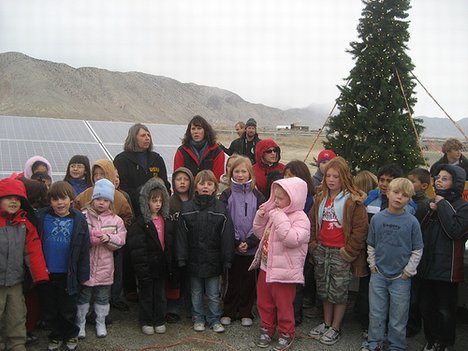By Amy Mayer
January 14, 2008
Wi-Fi plays a crucial philanthropic and educational role as Burning Man artists and organizers donate what could amount to millions of dollars in free electricity to schools and a hospital in Nevada.
Related Articles
- Here Comes the Sun
- Going Green
- 3G & Wi-Fi Help Rebuild
- Boulder Gets Solar-Powered Wi-Fi
- The Wireless Artist
- Proxim, Hutton Ship Solar-Powered Wireless Camera
For years, Burning Man has lured thousands of people to the Black Rock desert in northern Nevada. Though members of the temporary community take every sign of their presence away each year when Burning Man ends, the impact on the small towns closest to the site remains significant. The effects are both positive and negative, says Tom Price, executive director of Black Rock Solar, a non-profit formed by Burning Man participants with the goal of speeding the adoption of renewable energy by giving away no- or low-cost solar arrays.
“We wanted to give something back to the communities that are impacted by our presence and that have been such good hosts,” Price says. The 300 or so days of sunshine and generous utility company rebates in Nevada led the group to propose bringing solar power to public buildings. The arrays are installed at little or no cost to the recipient and the savings could be significant.
“Solar power’s usually been the exclusive purview of large institutions or wealthy do-gooders, because it’s so expensive,” Price says. But Black Rock partnered with MMA Renewable Ventures, Sierra Pacific Power, and the Washoe County School District and in December flipped the switch on a 90 kilowatt, ground-mounted solar array for the Gerlach schools. Black Rock also installed a solar array for a hospital in Lovelock, Nevada.
“We’ve married fiscal capital to social capital to give even small rural communities a seat at the renewable energy table,” he says. Rebates from the utility just about cover the costs incurred, says Price. Moving forward into future projects, he says any expenses beyond the rebates will be easily covered by savings.
Though calculations predict how much energy the arrays will generate and how much cost-savings that translates into, the use of Wi-Fi monitoring means anyone with an Internet connection can actually see, in real time, what’s going on.
“It’s a really cool technology, it transmits directly from the array,” Price says. Once Gerlach is fully connected, Solar Generations will have a link on its “Solar: Up to the Minute” page for the installation. The array will wirelessly send information about the wattage currently being generated, the ambient conditions (temperature, wind) at the site, and the amount of greenhouse gas emissions avoided since the array was installed.
“You can look and see just how consistent, for example, the power is over the course of the year,” Price says.
Plus, the Wi-Fi monitoring element of the project provides a real-life, real-time learning opportunity for the students using the solar power, he says.
Even more empowering for the Gerlach schools, Price says, is the agreement made with the school district. The Gerlach schools will continue to receive the full amount of their current energy budget, despite getting most of its power from the solar array. As the conventional utility bills drop—Price predicts by approximately 95 percent in the first year—the school can use the money it saves for other things. Price says he’s heard these rural, desert-dwelling kids are planning a trip to the Monterey Bay Aquarium.

Students on the Gerlach, NV school campus with their new solar arrays.
This is not the first time that Burning Man participants have used Wi-Fi to make a difference in a community. After Hurricane Katrina, a large group of Burners went straight from the event to parts of Mississippi and Louisiana that had been devastated by the storm. They called themselves “Burners Without Borders,” and the tech-savvy band of creative thinkers used the newly released Kyocera KR1 Mobile Router ($299) to set up a Wi-Fi LAN using an EV-DO 3G connection for backhaul to the Internet.
“We’ve finished our project,” said Price of the Katrina relief effort in a 2006 interview with Wi-Fi Planet. “But the KR1 is going in the initial deployment box with our chainsaw, our tools, our generators…If you’re going to work in an unstable environment, this about as close to plug-and-play connectivity as you can get. Quite simply, without the KR1 router, we would have folded up our tents and left months before we did…Being able to create a hotspot in a disaster zone literally in the middle of a swamp? It was mission-critical. It was equally important as our bulldozers.”
- Mesh Network in Iraq Gets Soldiers Online - September 25, 2008
- Carpe Diem: BelAir Seizes New Opportunities in Muni Wi-Fi - February 28, 2008
- Muni Mesh Proving its “Mettle” in Minneapolis - February 20, 2008